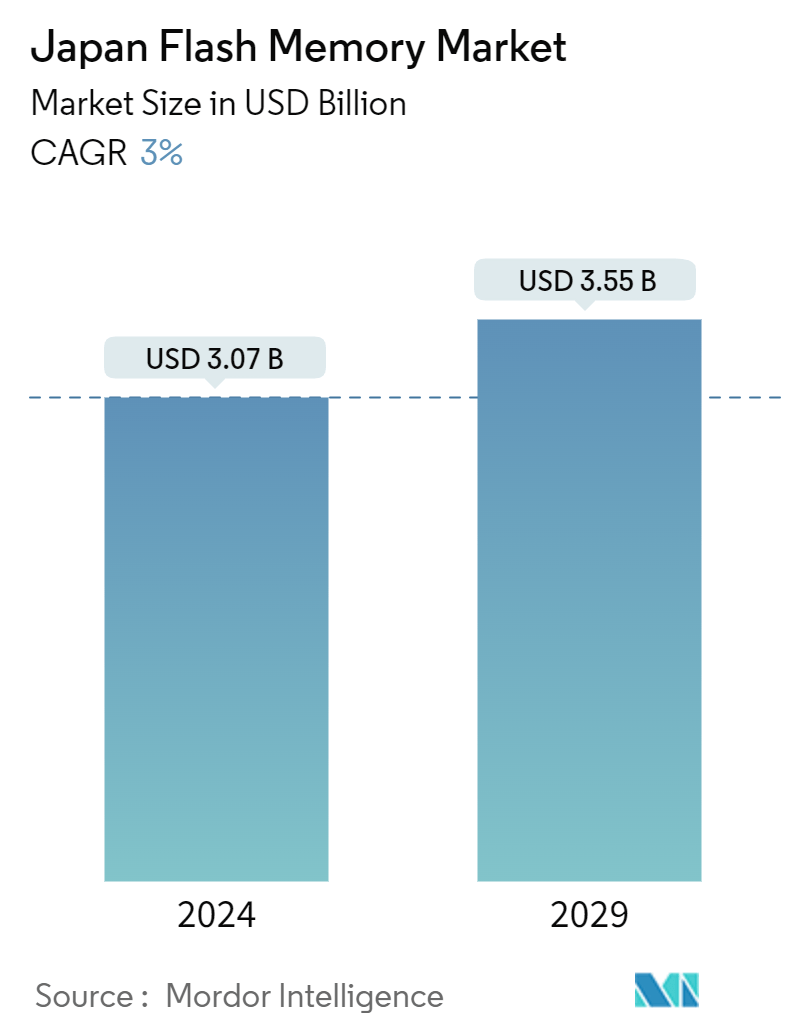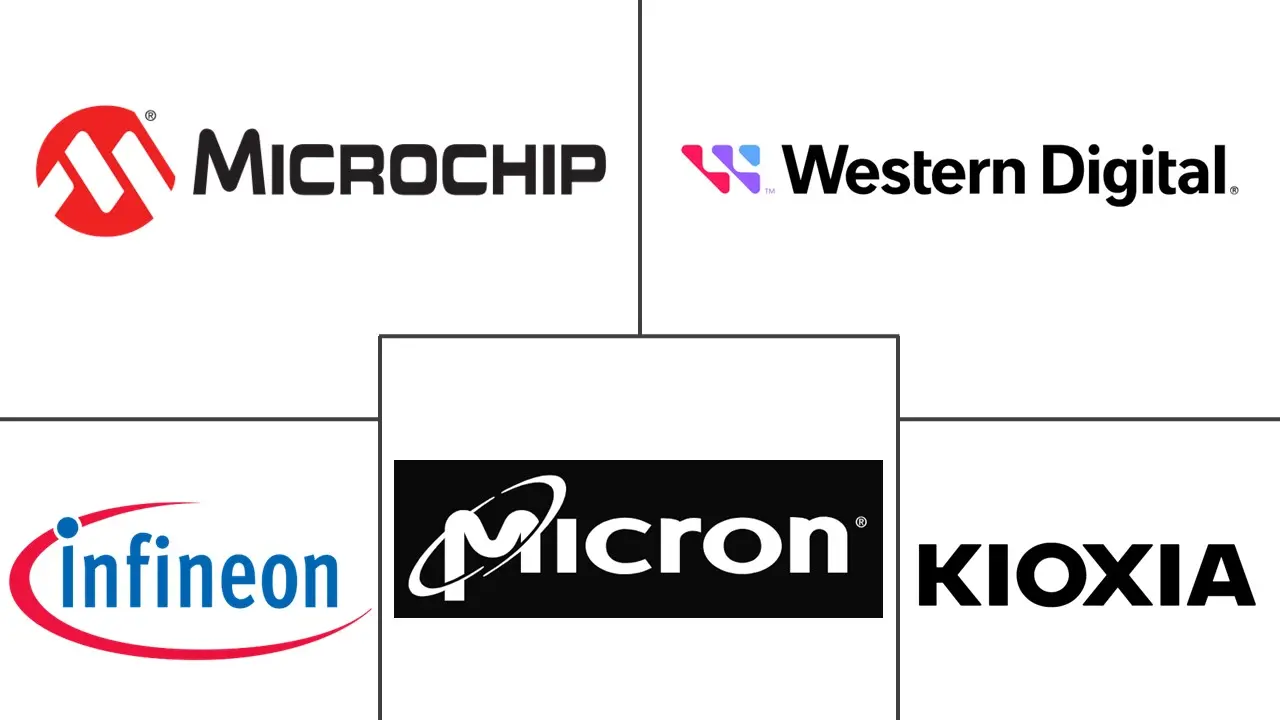Market Size of Japan Flash Memory Industry

| Study Period | 2019 - 2029 |
| Base Year For Estimation | 2023 |
| Forecast Data Period | 2024 - 2029 |
| Market Size (2024) | USD 3.07 Billion |
| Market Size (2029) | USD 3.55 Billion |
| CAGR (2024 - 2029) | 3.00 % |
| Market Concentration | High |
Major Players
*Disclaimer: Major Players sorted in no particular order |
Japan Flash Memory Market Analysis
The Japan Flash Memory Market size is estimated at USD 3.07 billion in 2024, and is expected to reach USD 3.55 billion by 2029, growing at a CAGR of 3% during the forecast period (2024-2029).
The market growth is driven by the rising demand for consumer electronics and automobiles manufacturing in the country. In addition, the developments of memory fabs and government incentives drive the market toward a growth trajectory.
- The demand for flash memory gained traction owing to increased penetration of the 5G network and demand for smartphones with advanced features and network capabilities such as 5G. High-performance smartphones consume high energy; thus, smartphone manufacturers are focusing on adopting flash memory in the next-generation smartphones to reduce power consumption and deliver high performance to consumers. For instance, in December 2022, As per the Japan Electronics and information technology Industries Association, the monthly domestic smartphone shipment volume reached 930,000 units in December 2022 compared to 590,000 in November 2022.
- Memory products to gain demand in coming years as the volume of data produced every second continues to rise. Thus, key vendors focus on spending billions of dollars to develop memory fabs and increase production capacity. For instance, in October 2022, Japan's Kioxia launched a new memory fab (Fab7) at Yokkaichi amid the market downturn. Fab7 is expected to increase the total production capacity of the Yokkaichi plant by 30%
- Government support to increase the production of NAND flash memory and memory fabs in the country fuel the market growth. For instance, in July 2022, the Japanese Government announced a subsidy of USD 680 million to Kioxia Holdings and Western Digital Corp to boost the production of NAND flash memory. The government aims to stabilize the chip production in the country.
- With the improvements in cell structure and the resulting increase in storage density, NAND flash technology is gaining popularity across market segments. This enables this non-volatile memory chip to considerably reduce the die size while providing faster throughput and better bandwidth at the system level. Innovations in the NAND flash and NOR flash memory are keeping pace with the accelerating demands in a data-centric world. The rise in demand for high-capacity storage to store, process, and manage vast amounts of data at higher speed and lower power consumption accelerates market growth.
Japan Flash Memory Industry Segmentation
Flash memory is a type of non-volatile memory that electronically erases data in blocks and rewrites the data at the byte level. There are two types of flash memory - NOR flash and NAND flash. Flash memory is widely used for storage and data transfer in consumer devices, enterprise systems, and industrial applications. The market study comprises the value and volume of flash memory.
Japan Flash Memory market is segmented by type (NOR Flash Memory (by density [2 MEGABIT & LESS, 4 MEGABIT & LESS (greater than 2MB), 8 MEGABIT & LESS (greater than 4MB), 16 MEGABIT & LESS (greater than 8MB), 32 MEGABIT & LESS (greater than 16MB), 64 MEGABIT & LESS (greater than 32MB)]), NAND flash memory (by density [128 MB & LESS, 512 MB & LESS, 2 GIGABIT & LESS (greater than 1GB), 256 MB & LESS, 1 GIGABIT & LESS, 4 GIGABIT & LESS (greater than 2GB)]), by end user (data center (enterprise and servers), automotive, mobile and tablet, client (PC, client SSD)), other end-user applications). The report offers market forecasts and size in value (USD) for all the above segments.
| By Type | ||||||||||
| ||||||||||
|
| By End User | |
| Data Center (Enterprise and Servers) | |
| Automotive | |
| Mobile & Tablets | |
| Client (PC, Client SSD) | |
| Other End-user Applications |
Japan Flash Memory Market Size Summary
The Japan flash memory market is poised for steady growth over the forecast period, driven by increasing demand in consumer electronics and the automotive sector. The expansion of memory fabs and supportive government policies are key factors propelling the market forward. The penetration of 5G networks and the demand for high-performance smartphones are significant contributors to the rising need for flash memory, as these devices require efficient storage solutions to manage advanced features and reduce power consumption. The automotive industry, particularly with the rise of electric vehicles and autonomous driving technologies, is expected to capture a substantial share of the market. This is due to the growing need for high-capacity storage to handle the vast amounts of data generated by sensors and cameras in modern vehicles.
The market is characterized by moderate consolidation, with major players like Micron Memory Japan Inc., KIOXIA Corporation, and Western Digital Corp. leading the industry. These companies are heavily investing in research and development to innovate and expand their production capabilities. Government initiatives, such as subsidies for NAND flash memory production, further support market growth by stabilizing chip production in the country. The advancements in NAND and NOR flash technologies, offering higher storage densities and improved performance, are also driving demand across various sectors, including industrial robotics and IoT devices. As Japan continues to be a leader in automotive and electronics manufacturing, the flash memory market is expected to experience sustained growth, supported by technological advancements and strategic investments.
Japan Flash Memory Market Size - Table of Contents
-
1. MARKET INSIGHTS
-
1.1 Market Overview
-
1.2 Supply Chain Analysis
-
1.3 Impact of macro trends (post-COVID-19 scenario, supply chain disruptions, and economic uncertainties among others) on the Market
-
1.4 Industry Attractiveness - Porter's Five Forces Analysis
-
1.4.1 Threat of New Entrants
-
1.4.2 Bargaining Power of Buyers/Consumers
-
1.4.3 Bargaining Power of Suppliers
-
1.4.4 Threat of Substitute Products
-
1.4.5 Intensity of Competitive Rivalry
-
-
-
2. MARKET SEGMENTATION
-
2.1 By Type
-
2.1.1 NAND Flash Memory
-
2.1.1.1 By Density
-
2.1.1.1.1 128 MB & LESS
-
2.1.1.1.2 512 MB & LESS
-
2.1.1.1.3 2 GIGABIT & LESS (greater than 1GB)
-
2.1.1.1.4 256 MB & LESS
-
2.1.1.1.5 1 GIGABIT & LESS
-
2.1.1.1.6 4 GIGABIT & LESS (greater than 2GB)
-
-
-
2.1.2 NOR Flash Memory
-
2.1.2.1 By Density
-
2.1.2.1.1 2 MEGABIT & LESS
-
2.1.2.1.2 4 MEGABIT & LESS (greater than 2MB)
-
2.1.2.1.3 8 MEGABIT & LESS (greater than 4MB)
-
2.1.2.1.4 16 MEGABIT & LESS (greater than 8MB)
-
2.1.2.1.5 32 MEGABIT & LESS (greater than 16MB)
-
2.1.2.1.6 64 MEGABIT & LESS (greater than 32MB)
-
-
-
-
2.2 By End User
-
2.2.1 Data Center (Enterprise and Servers)
-
2.2.2 Automotive
-
2.2.3 Mobile & Tablets
-
2.2.4 Client (PC, Client SSD)
-
2.2.5 Other End-user Applications
-
-
Japan Flash Memory Market Size FAQs
How big is the Japan Flash Memory Market?
The Japan Flash Memory Market size is expected to reach USD 3.16 billion in 2025 and grow at a CAGR of 3% to reach USD 3.67 billion by 2030.
What is the current Japan Flash Memory Market size?
In 2025, the Japan Flash Memory Market size is expected to reach USD 3.16 billion.

